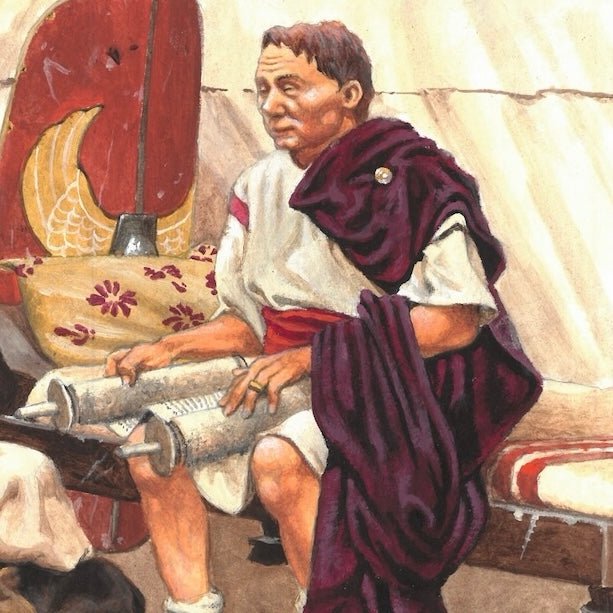Egyptian soldiers in the Roman army
Earlier this evening, I attended a lecture by Prof. Arthur Verhoogt with the title ‘Egyptian young men in the Roman army: soldiers’ letters from Egypt’. Verhoogt works at the University of Michigan and is currently Fellow-in-Residence at the Netherlands Institute for Advanced Study (NIAS). The lecture was organized by Leiden University and took place in the main hall of the National Museum of Antiquities.
During the lecture, Arthur Verhoogt discussed a number of letters and other documents preserved on papyri that all give insights into the life of Egyptian soldiers in the Roman army. All of the fragments came from the Egyptian village of Karanis and date to the first two centuries AD, as this is the focus of Verhoogt’s ongoing research. Karanis was located in the Faiyum region, one of the most fertile areas in Egypt.
Part 1: introduction
The lecture consisted of two parts. During the first half, Verhoogt spent some time to discuss the Roman army. Of all institutions of the ancient world, the Roman army has received the most attention, but that doesn’t mean that there are no mysteries left. There are loads of different types of evidence available that give insights into the Roman army, including archaeological finds, such as fortifications and weapons, as well as papyri.
Another aspect that Verhoogt emphasized was the cultural diversity within ancient Egypt at that time. There were those who identified themselves closely with the original Egyptians, and who spoke Egyptian and lived their lives in a particular way. There were also people who were more thoroughly Hellenized, who identified themselves more closely with the Greek culture that was introduced by Alexander the Great, and who spoke Greek and visited gymnasia and other Greek institutes.
Genetically speaking, there may not have been big differences between these groups of people, but culturally there were, even though to the Romans they were all simply ‘Egyptian’. Most of the letters discussed by Verhoogt were written in Greek, though some have also been found that were written in Latin.
Verhoogt also provided some numbers. During the first century AD, there may have been around 17,000 soldiers in Egypt in all. This number decreased slightly in the second century AD, when legions were redistributed. Interestingly enough, Verhoogt emphasized that Egyptian troops were not all limited to serve as auxiliaries: there are examples of soldiers who were not Roman citizens, but who nevertheless did serve in the legions and who, like auxiliaries, were awarded citizenship after their tour of duty was over.
The papyri uncovered in Karanis allow researchers to reconstruct large parts of these soldiers’ lives. Verhoogt was quick to point out that the papyri don’t necessary reflect life in the Roman army at large, but instead are typical only perhaps for a particular region, a particular time, and perhaps also – I would add – a particular group of people. The papyri consist of letters written from one soldier to another, as well as soldiers’ letters that were sent back to the home front.
Part 2: letters of Roman soldiers
During the second part of the lecture, Verhoogt showed a number of examples of papyri. Some of these were written by the soldiers themselves, while others were dictated. Interestingly, wealthy soldiers would probably have opted to have had their letters dictated, as writing was considered hand work and thus not suited to a man of leisure.
Indeed, this raises an interesting point. One of the letters discussed by Verhoogt concerned a man called Gaius Julius Apollinarius. A great many of his letters have been discovered, as well as letters written by other members of his family, unearthed in the remains of a massive granary. His father, for example, was Gaius Julius Sabinus, who was not a Roman citizen when he joined the army and whose name was changed to the Roman form after signing up. Apollinarius was a wealthy man, who owned farmland, an olive grove, and even, at one point, possessed an apartment in the Empire’s capital city.
For poor people, the army offered decent wages and a pension. But what possessed a wealthy Roman citizen like Apollinarius to join the army? Verhoogt suggests that service in the army would have been a good way for even a wealthy man to rise further in the ranks and to gain acquaintances who would help further his career even after his term of service was over.
The letters make clear that if you wanted to get promotion, you had to go out there and simply ask for it. Apollinarius, for example, asked the legion’s tribune, Claudius Severus (perhaps the same who would later become prefect of Arabia), to become the legion’s secretary.
All in all, this was a very interesting lecture. If you want to have a look yourself, there’s an online exhibition showcasing some papyri on the website of the Leiden Papyrological Instute.




